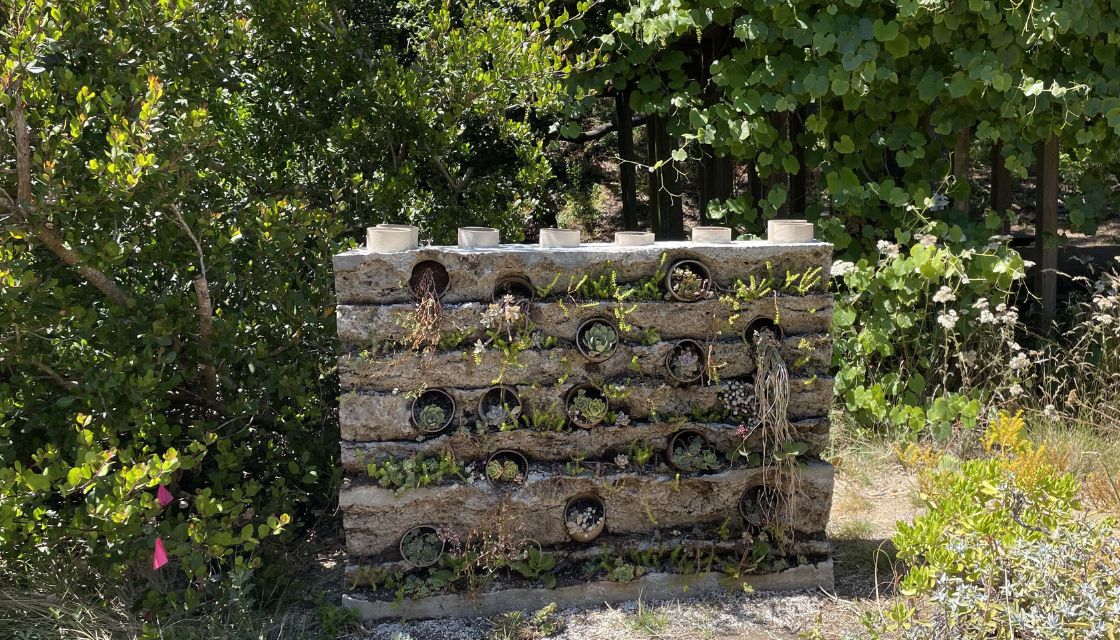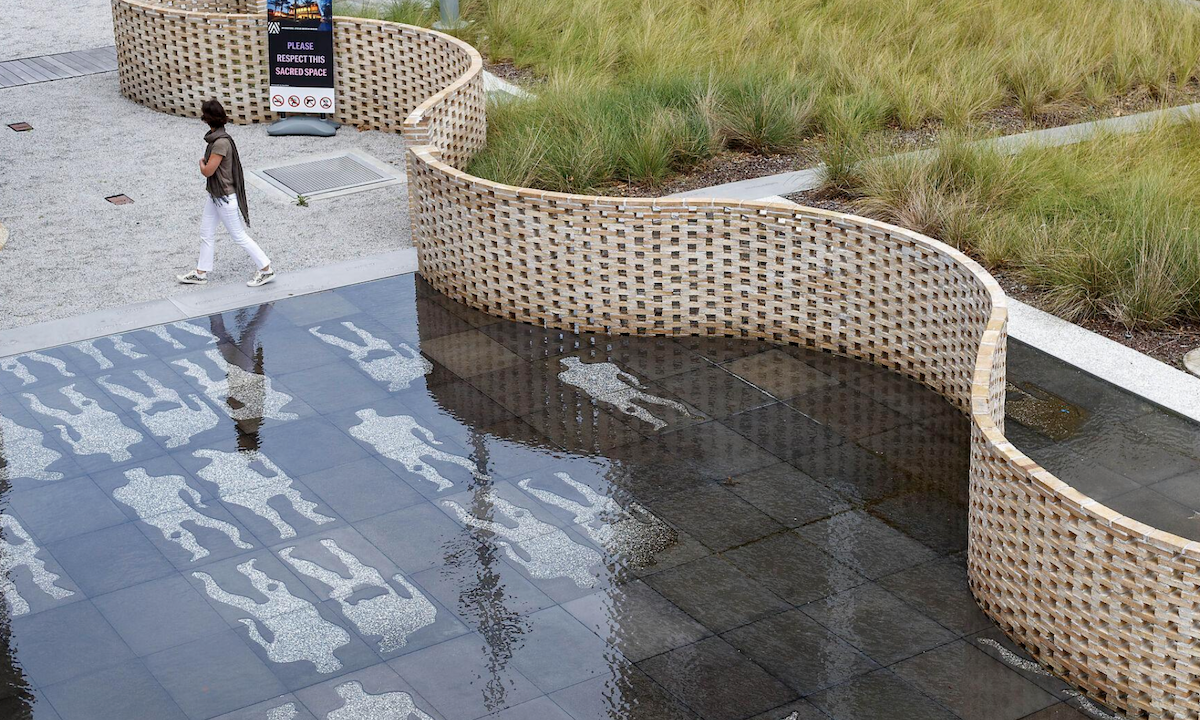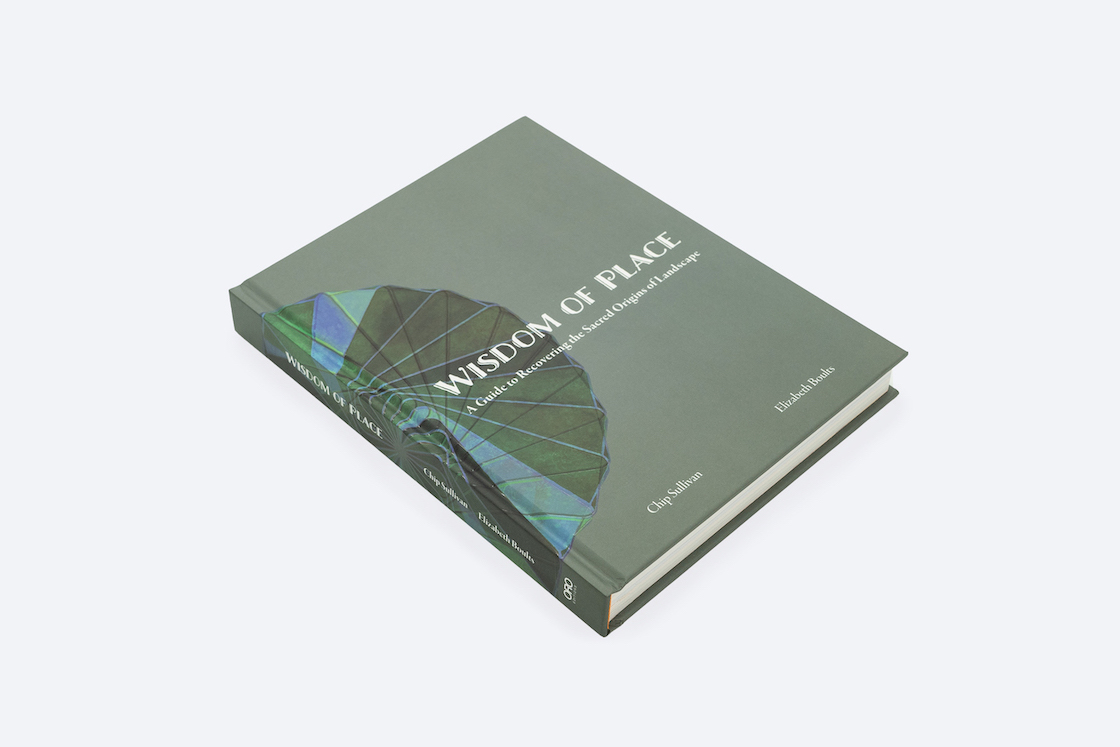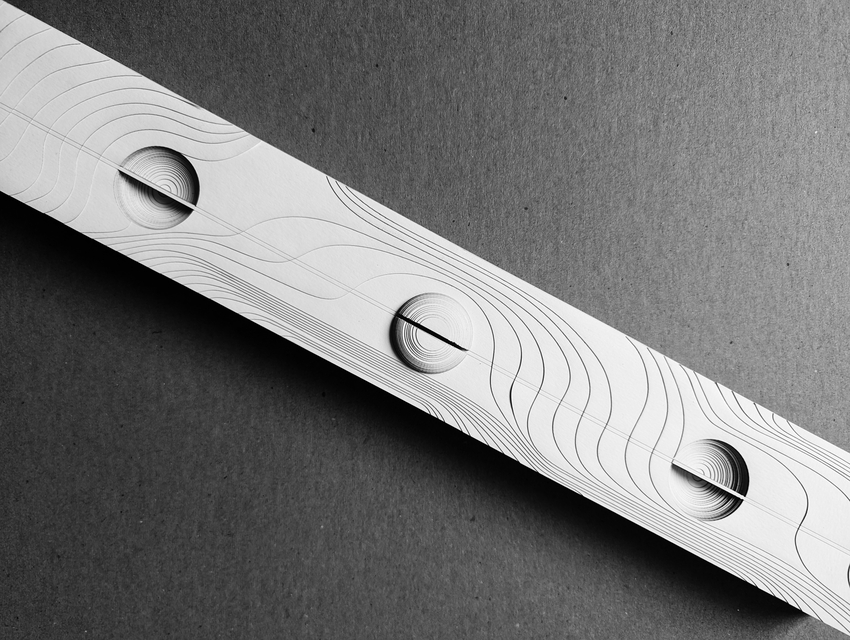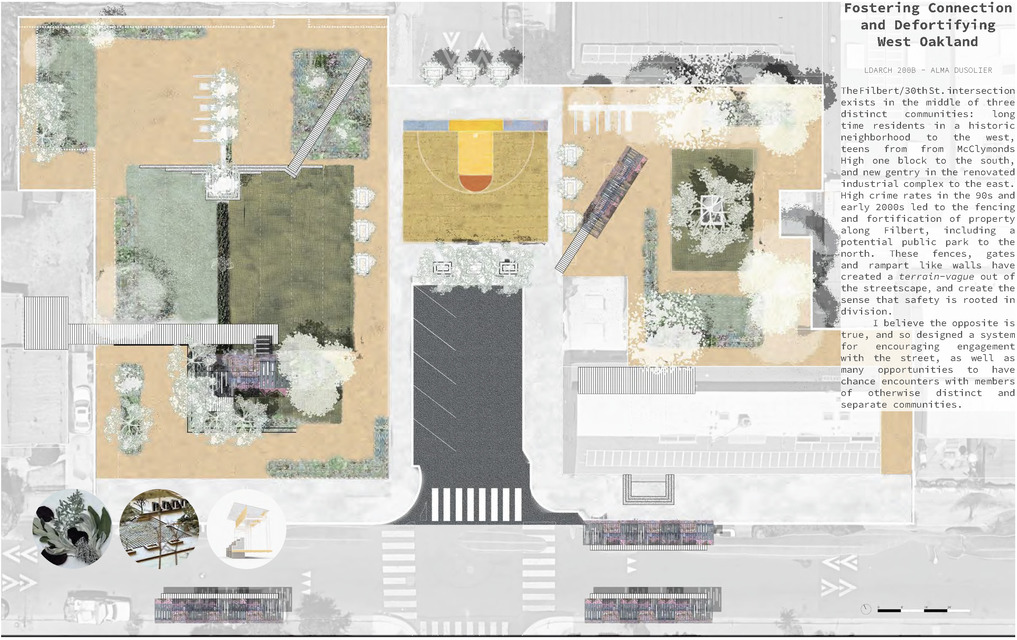Master of Landscape Architecture
Berkeley’s Master of Landscape Architecture integrates design excellence and innovation with ecological integrity and social justice. As an MLA candidate, you’ll engage with landscapes on a range of scales, from residential gardens to wilderness areas, with a special concern for the public realm. Our program empowers you to think critically about the performance of landscape spaces and systems through the lenses of environmental justice, cultural meaning, and visual form.

A key strength of Berkeley’s MLA program is that it brings together designers and scientists. In the landscape architecture track, you’ll learn how to apply social and ecological science to design and planning, while in the environmental planning track, you’ll develop a keen awareness of how design intersects with land-use decisions. Our MLA program prepares you for careers in private design firms, public agencies, and nonprofit organizations, as well as teaching positions at leading institutions.
ABOUT THE MASTER OF LANDSCAPE ARCHITECTURE
Berkeley’s Master of Landscape Architecture is centered around both design studio and fieldwork. As an MLA student, you’ll work closely with your classmates and professors in our light-filled open-plan studio to develop and represent your design ideas. You’ll also be out in the field, identifying plants at Blake Garden, participating in river restoration projects, monitoring air quality, and more. We encourage you to identify your own creative and research passions, with the support of your faculty advisor.
In the environmental planning track (MLA EP), you’ll develop skill sets to integrate information from various disciplines — geology, soils, hydrology, plant and wildlife ecology, law, and public policy — and present it in ways both comprehensible and compelling to decision makers.

“Berkeley’s MLA is one of few programs that combines design and science, using landscape as a tool to reshape the public realm.” — Walter Hood, Chair
Why Berkeley

Offering you a rich intellectual community rooted in the dynamic contexts of UC Berkeley, the Bay Area, and beyond, California is the ideal place to study landscape architecture and environmental planning. As the birthplace of social justice advocacy and the environmental movement, 21st-century California brings issues of equity, urbanization, and climate change into stark relief. Its diverse population, 40 million strong, and its rich and varied environmental conditions — coasts, deserts, mountains, cities, suburbs, exurbs, and agricultural regions — makes it the ideal laboratory for our discipline.
As a UC Berkeley graduate student, you will be studying at the number one public university in the United States alongside the brightest and most passionate students from across the globe. Berkeley’s environment of critical inquiry, discovery, and innovation is informed by a deep commitment to contributing to a better world.
About the College of Environmental Design
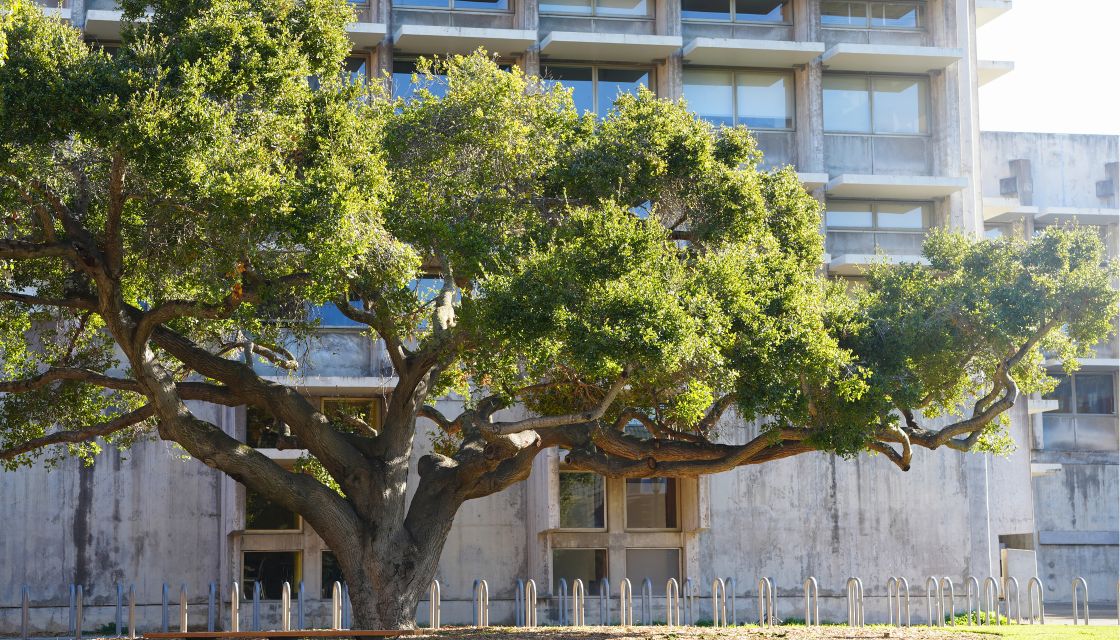
The Department of Landscape Architecture & Environmental Planning (LAEP), established at UC Berkeley in 1913, was one of the founding departments in the College of Environmental Design. When the college was created in 1959, it was the first in the nation to unite the disciplines of architecture, planning, and landscape architecture, leading the way toward an integrated approach to analyzing, understanding, and designing our built environment. The college emphasizes environmental design as a profoundly ethical practice, inseparable from social, political, economic, and cultural contexts and co-produced through dynamic engagements with diverse communities.
Faculty
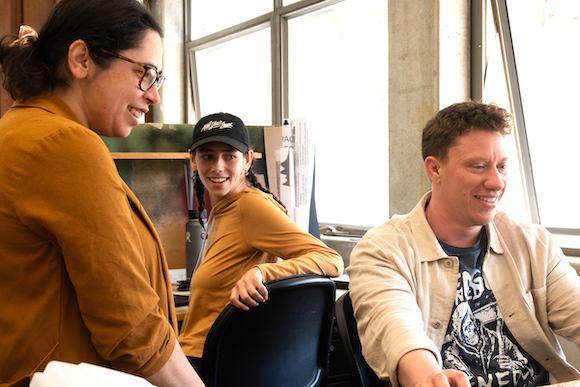
LAEP is a small department, so you’ll develop close ties with our eminent faculty. As an incoming MLA student, you’ll be matched with a faculty advisor, who will help guide you as you begin to define the focus for your education.
Our multidisciplinary faculty have backgrounds in design, science, and planning — all grounded in a shared value for environmental justice and commitment to address the changing climate. They engage in research and teaching across a range of landscape scales to build inclusive, vibrant cities; construct resilient metropolitan ecologies; restore degraded ecosystems; and meet the challenge of climate change. Their research includes the design of innovative public spaces, from small-scale green spaces, streetscapes, and public plazas, to planning for ecological infrastructure, resource-efficient community design, urban forestry and environmental restoration, and landscape ecology.
- Faculty Specializations
- landscape design
- urban design
- urban water systems
- landscape and plant technologies
- environmental science
- remote sensing and spatial analysis
- mapping and data visualization
- landscape ecology
- community-based planning
- coastal adaptation to sea level rise
- river systems
- wetland science
- hydrology
- natural resource management
- landscape history and theory
Faculty Work
MLA Degree Tracks
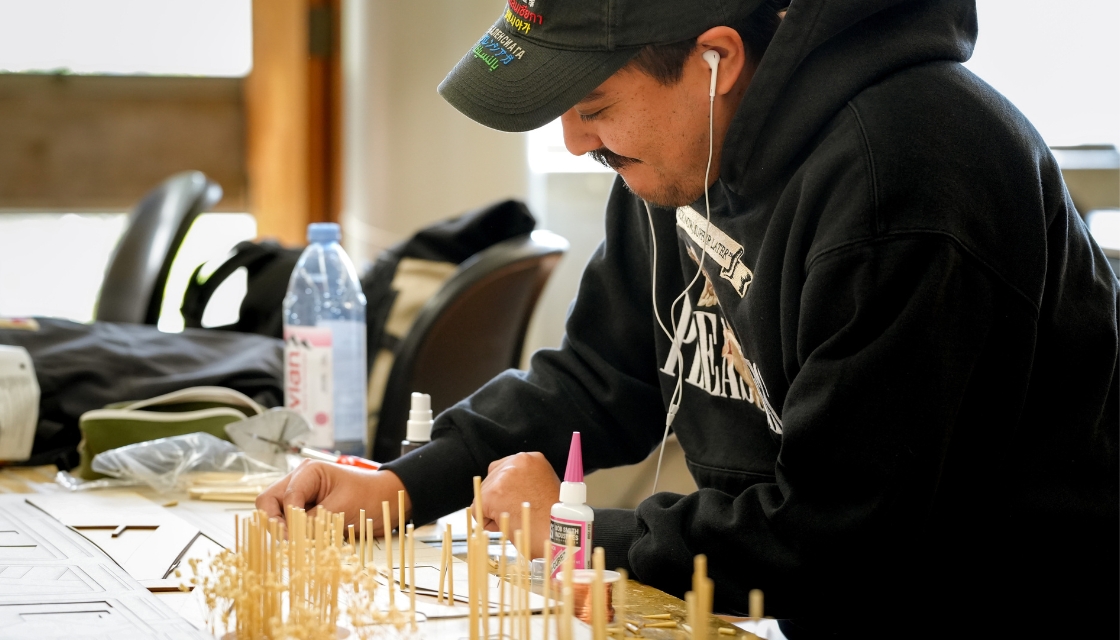
MLA 3D: three-year degree track
The three-year MLA (3D) is the first professional degree for students with non-design backgrounds. We welcome students with undergraduate degrees in any discipline.
In this track, you’ll learn to apply scientific methods and harness your knowledge of plant and construction materials to design meaningful landscapes. It’s organized around the core design studio, which is the setting for the synthesis and integration of technical, environmental, historical, and theoretical course offerings. Specialized modules introduced in the studio each semester may include: planting design, grading and earthwork, computer-aided design, materials and detailing, and drawing. At the end of your first year, you’ll be ready to join the incoming cohort of students in the two-year track.
- MLA 3D: Plan of Study
YEAR 1 Fall
LA 200A Fundamentals of Landscape Design 5
LA 234A Drawing the Landscape 3
LA C110A Ecological Analysis 4
LA 254 Special Topics in LAEP: 200A supplemental 1
YEAR 1 Spring
LA 200B Case Studies in Landscape Design 5
LA 234B Landscape Processes through Drawing and Modeling 3
LA 170 History and Literature of Landscape Architecture 3
LA 112 Landscape Plants: Identification and Use 4
YEAR 2 Fall
LA 201 Ecological Factors in Urban Landscape Design 5
LA 120 Topographic Form and Design Technology 3
LA 233 Drawn from the Field 3
Social Factors or Elective 3
YEAR 2 Spring
LA 202 Design of Landscape Sites 5
LA 121 Design in Detail: Introduction to Landscape Materials and Construction 4
Social Factors or Elective 3
YEAR 3 Fall
LA 203 Landscape Project Design OR
LA C203 Shaping the Public Realm 5
LA 252B Independent Research Preparatory Course OR Elective 3
Elective(s) 4
YEAR 3 Spring
LA 204 Advanced Project Design OR
LA 206 Final Project Preparation Studio: Thesis and Reports 5
LA 260 Professional Practice and Internship 3
Elective(s) 4
MLA 2D: two-year degree track
The two-year MLA is the second professional degree for students with first degrees in landscape architecture, architecture, or environmental design.
The MLA 2D provides flexibility for specialization in advanced design and research. If you have a background in architecture, you’ll take classes in plant identification and landscape history, while those who already have an undergraduate degree in landscape architecture have more flexibility in their program of study.
Like the three-year option, the 2D MLA is organized around the core design studio, which is the setting for the synthesis and integration of technical, environmental, historical, and theoretical course offerings. Specialized modules introduced in the studio each semester may include: planting design, grading and earthwork, computer-aided design, materials and detailing, and drawing. You’ll learn to apply scientific methods and harness your knowledge of plant and construction materials to design meaningful landscapes.
- MLA 2D: Plan of Study
Plan of study if you have an undergraduate degree in landscape architecture:
Year 1
LA 201 (5) Ecological Factors in Urban Landscape Design
LA 120 (3) Topographic Form and Design Technology
History or Structures/Infrastructure (3)
Elective (1)
LA 202 (5) Design of Landscape Sites or other CED Design Studio (see below)*
Natural Factors (5)
History or Structures/Infrastructures (2–3)
Elective (1–2)
Year 2
LA 203 (5) Landscape Project Design OR LAC203(5) Shaping the Public Realm
Social Factors (3)
LA252B Independent Research Preparatory Course (3) or elective (1)
Elective (3)
LA 204 (5) Advanced Project Design OR LA 206 (5) Final Project Preparation Studio: Thesis and Reports
LA 260 (3)Professional Practice and Internship
Elective (4)
Plan of study if you have an undergraduate degree in architecture:
Year 1
LA 201 (5) Ecological Factors in Urban Landscape Design
LA 120 (3) Topographic Form and Design Technology
LA C110A (4) Ecological Analysis
LA 202 (5) Design of Landscape Sites
LA 170 (3) History and Literature of Landscape Architecture
LA 112 (4) Landscape Plants: Identification and Use
Year 2
LA 203 (5) Landscape Project Design OR LA C203(5) Shaping the Public Realm
Social Factors (3)
LA 252B (3) Independent Research Preparatory Course or Elective
Elective (1)
LA 204 (5) Advanced Project Design OR LA 206 (5) Final Project Preparation Studio: These and Reports
LA 260 (3) Professional Practice and Internship
LA 121 (4) Design in Detail: Introduction to Landscape Materials and Construction
MLA EP: Two-year Environmental Planning Track
If you have a strong background in the environmental sciences or management, and if you want to work at the nexus of science and design to impact land use policy, the two-year environmental planning MLA degree (MLA EP) might be the right fit for you. As an environmental planner, you’ll apply the natural and social sciences to promote environmentally sound development and management of natural resources. broad field that bridges the disciplines of geology, soils, hydrology, plant and wildlife ecology, law, and public policy. With a MLA in environmental planning, you will learn how to bring analytical, managerial, and policy-making skills to bear on decisions about the appropriate use of land and natural resources.
You’ll acquire the skills to act as an intermediary between natural scientists and planning agencies, using landscape architectural physical planning and site design to inspire more creative and ecologically informed plans and to help mitigate the detrimental effects of development.
- MLA EP Plan of Study
YEAR 1 Fall
LA 200A Fundamentals of Landscape Design 5
LA 234A Drawing the Landscape 3
LA C188 Geographic Information Systems 4
LA 254 Special Topics in LAEP: 200A supplemental 1
YEAR 1 Spring
LA 205 Environmental Planning Studio 5
Natural Factors 3
LA 221 Quantitative Methods in Environmental Planning 3
Elective 1
YEAR 2 Fall
LA 252B Independent Research Preparatory Course3
Social Factors or Elective 3
History or Elective 3
Elective 3
YEAR 2 Spring
LA 206 Final Project Preparation Studio: Thesis and Reports 5
LA 237 The Process of Environmental Planning 3
Social Factors or History 3
Elective 1 or 4
Capstone Projects
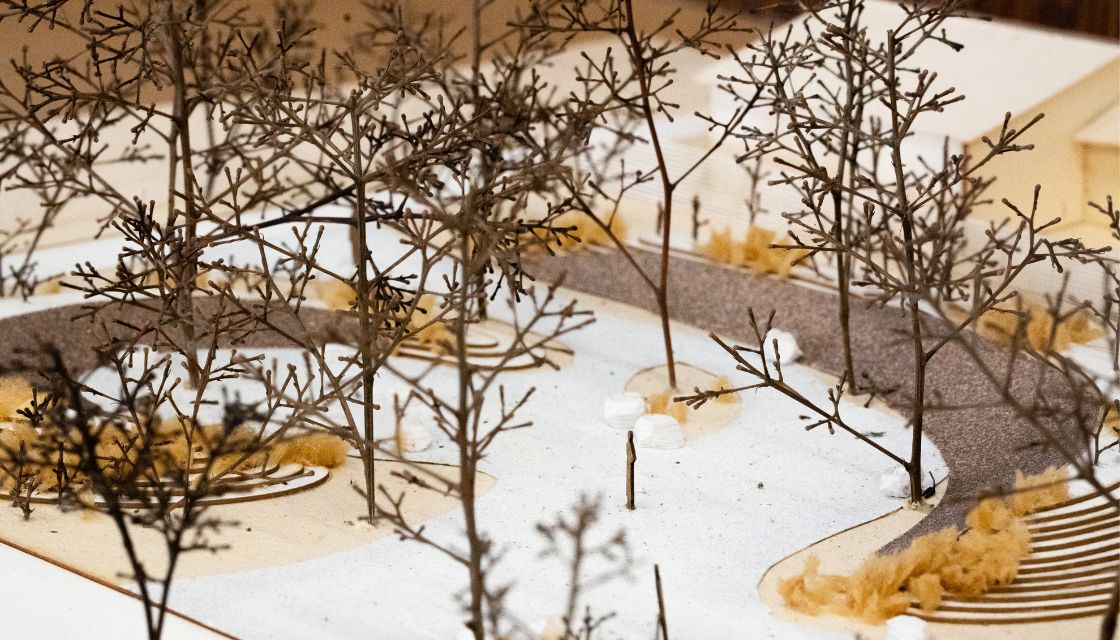
In your final year of the MLA program, you have the choice between completing a thesis or comprehensive exam, which can take the form of a professional project or designated studio. The thesis is for students who wish to do original research on a problem in landscape architecture or environmental planning.
Recent Thesis Topics
- Safer Together: Collective Wildfire Mitigation in California’s Mobile Home Parks
- Collage, Animation, and Climate Futures: Arts-Based Approaches to Radical Imagination in Richmond, California
- A Culture of Change: The Inherent Power of Restorative Justice to Transform Public Schoolyards
- Flood Risk Screening for Rivers Across the U.S.-Mexico Border
- A Fifth Ecology for Los Angeles: Interactions with the Upper Dominguez Channel
- Field Conditions: Developing a Composite Understanding of Brownfield Sites
- Get in the Bay: Towards a Swimmable East Bay
- More than Mud: Socioecological State of Sediment in the Lower Terrebonne Basin of Coastal Louisiana
- On the Hoof — A Multispecies Movement Design for Golden Gate Park
The option for those who do not wish to complete a thesis is a comprehensive exam, which can take the form of either a professional project or, for MLA 2D and 3D only, a designated studio that demonstrates broad competence plus the concepts and skills necessary to the field of landscape architecture
The professional project consists of a report of not more than 40 pages of text with appropriate professional drawings that documents a real-world project.
Alternatively, you can fulfill the final degree requirement through the successful completion of a comprehensive exam studio taken in your final semester. Please note: Students who are in the environmental planning track or in one of the concurrent degree programs are not eligible for the comprehensive exam studio option.
Concurrent Degrees
At CED, you can expand your course of study by earning either a Master of Architecture or a Master of City Planning degree alongside your MLA.
Student Work
Blake Garden
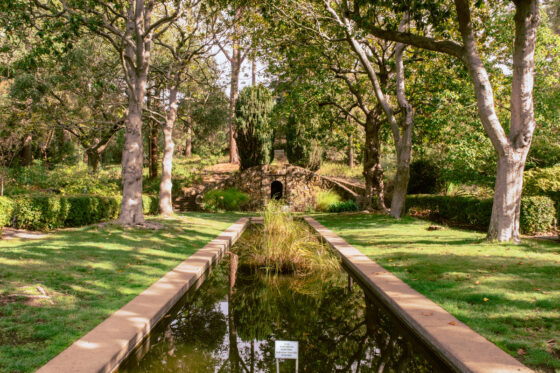
Blake Garden is the ideal spot for hands-on study and experimentation for MLA students — occupying more than 10 acres of rolling terrain in Kensington, featuring large rock outcroppings, several reaches of Cerrito Creek, and sweeping views of the San Francisco Bay. As an MLA student, you’ll take your plant identification courses here and have opportunities to site independent study projects in the garden. And only students in Berkeley’s Department of Landscape Architecture & Environmental Planning get to celebrate their graduations at this special spot.
Student Organizations
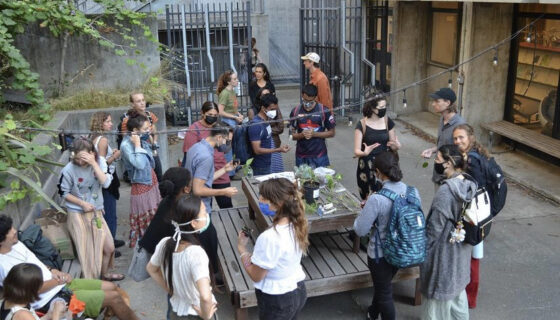
Get involved with the American Society of Landscape Architects’ student chapter! Berkeley’s ASLA coordinates professional development and skill-building opportunities, organizes social and community service activities, and represents the student’s voice at faculty and curriculum committee meetings. Follow.
Graduate Student Journal
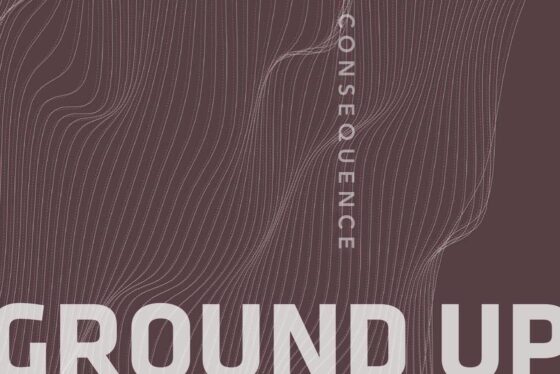
Ground Up is the award-winning graduate student journal of Berkeley’s Department of Landscape Architecture & Environmental Planning. Published annually, the journal bridges the gaps between student and professional, academia and practice, landscape and architecture, while exploring contemporary issues in the built environment in unexpected, thoughtful, and compelling ways.
Internships + Careers
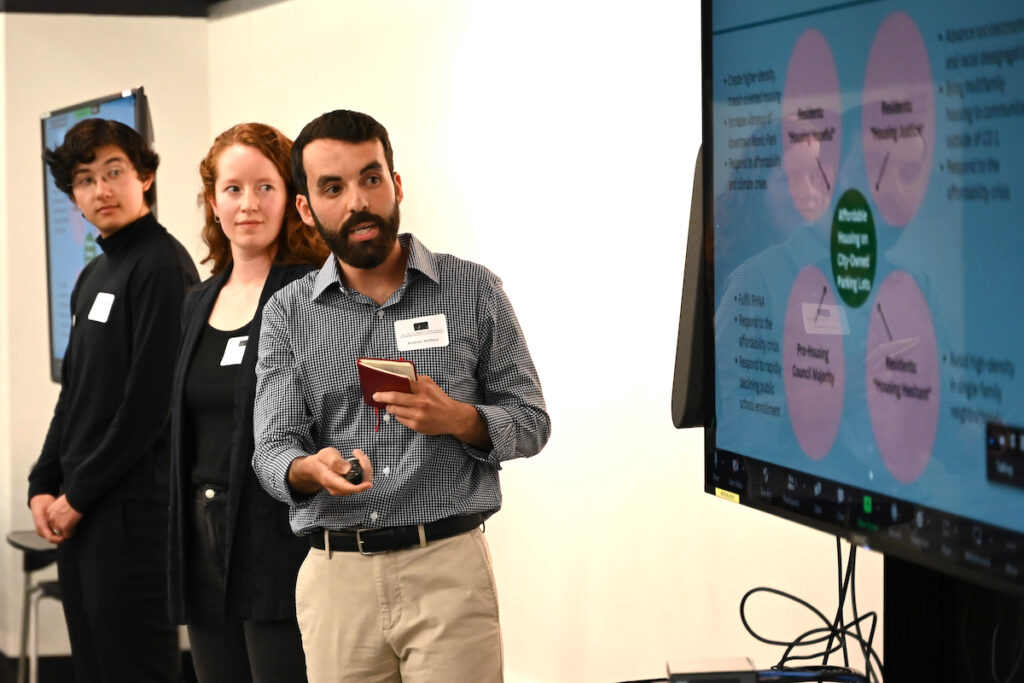
In your final semester, you’ll take our professional practice course, which prepares you for your future job search and career. You will be matched with a local professional for an internship and will learn networking, interviewing, and resume-writing skills. You’ll also have opportunities to meet alums and learn what it means to be a practicing, licensed landscape architect.
All of our students also have access to one-on-one counseling offered by the College of Environmental Design career counselor, as well as Berkeley’s robust career services, for up to two years after graduation.
The depth and reach of our pedagogy well prepares you to join design and planning consulting firms, public agencies, and nonprofit organizations as well as to hold teaching positions at leading institutions around the world. Our graduates are prepared to serve as national and international landscape design and planning leaders, building thriving communities in a world of rapid political, economic, and environmental change.
Graduates of the environmental planning track work in a variety of professional settings, including the U.S. Forest Service, Park Service, Bureau of Land Management, state and regional agencies responsible for management of natural resources and protection of sensitive areas. Some are employed in firms that undertake large-scale analyses and plans for public agencies, and the design of privately financed development projects. Others work with international development agencies or nongovernmental organizations concerned with preservation of environmental values.
- Selected Employers
- National Park Service
- American Ramp Company, Joplin, Missouri
- SWA Group, San Francisco
- Arup, Shenzhen, Guangdong, China
- Einwiller Kuehl, Oakland
- Bay Tree Design, Berkeley
- City of Berkeley (Planning Commission)
- Perkins&Will, San Francisco
- PlaceWorks, Berkeley
- University of Hawaii
- The Ohio State University
- University of New Mexico
- University of Washington, Seattle
Accreditation
Public Information Policy Programs accredited by the Landscape Architectural Accreditation Board (LAAB) are required to provide reliable information to the public. Programs must report on accreditation status and its performance. This information is to help potential students make informed application decisions. Review the department’s LAAB disclosure.
Financing Your Education
We are committed to recruiting students of outstanding achievement and potential, regardless of ability to pay.
- Fees + Financial Aid
- Fellowships
- Arcus Social Justice Corps Fellowship
In addition to tuition, UC Berkeley students pay several types of fees, including a campus fee, student services fee, and others. Students enrolled in professional degree programs, including the MLA, are also charged Professional Degree Supplemental Tuition (PDST).Find current tuition and fee information at Office of the Registrar.
The Department of Landscape Architecture & Environmental Planning offers several scholarships to incoming students, based on evidence of academic excellence. Notification of these nominative awards arrive with your acceptance letter. Students are also encouraged to apply for competitive university fellowships.
Find information about financial aid and student employment at Fees + Financial Aid.
Each year, CED and its departments award a limited number of fellowships for incoming domestic and international graduate students, based on merit and/or need. Departmental funding packages vary on a case-by-case basis. Applicants are considered for funding packages and financial support by each departmental admissions committee and are notified of any funding in their letters of admission; a separate fellowship application is not required. The university awards, through competition, a limited number of merit-based and diversity fellowships each year. We recommend that you also seek financial support independent of university sources. We encourage you to explore the fellowship database compiled by Grad Division.
As a CED student, you are also eligible to apply for numerous competitive scholarships, fellowships, prizes, awards, and internships.
If you are applying to one of CED’s master’s degree programs and intend to pursue social justice work after graduation, we encourage you to apply for the Arcus Social Justice Corps fellowship.
If you plan to pursue social impact work after earning your degree, we encourage you to apply for the Arcus Social Justice Corps fellowship, which provides full funding so you can graduate debt-free. Please note: the Arcus Fellowship is available only to domestic students.
UC Berkeley begins accepting applications in early September for the following fall term only (no spring admissions). The fall semester begins in mid-August.
HOW TO APPLY
We recommend you start the application process as soon as possible. As a prospective graduate student, you’ll submit your application through UC Berkeley’s Graduate Division. You’ll find lots of useful information on the Graduate Division website, including application instructions and information about funding your education.
- Review admissions requirements on the Graduate Division website
- Gather materials:
- Unofficial transcripts for each prior college or university attended
- Statement of Purpose. For tips on writing the Statement of Purpose, please see Writing the Statement of Purpose on the UC Berkeley Graduate Division website.
- Personal Statement. For tips on writing a Personal History Statement, please see the Personal Statement Guide on the UC Berkeley Graduate Division website.
- Optional collaboration statement
- Contact information for three recommenders
- Resume/CV
- Evidence of English language proficiency, if applicable. For waivers, visit the Graduate Division website.
- Names of two faculty members you are interested in working with and why. View faculty profiles.
- Portfolio (for MLA 2D and 3D only)
- A recent publication, report, or writing sample (MLA EP only)
- Information about relevant coursework
- List of relevant publications or presentation
- List of honors/awards
- URL of website where your work is published, if applicable
- Start your application on the Graduate Division website. You do not have to complete the entire application at one time: we recommend you start your application and review it as soon as possible.
- Scroll down and select Landscape Architecture MLA.
- Follow the instructions in the application. See below for MLA-specific instructions and specifications for supplemental materials.
- Pay fee.
- Submit application. Allow yourself at least one hour prior to the deadline to submit your application. Late applications or changes to the application after the deadline will NOT be accepted.
- After submitting your application, you will receive an email from UC Berkeley’s Graduate Admissions Office confirming your submission.
- We strongly encourage you to log back into your application to monitor the status of materials received/processed, such as fee waivers, test scores, and recommendations.
- We send admissions decisions, along with notification of fellowship awards, in late March.
Only online applications (including letters of recommendation) are accepted. All documents, regardless of language of instruction, must be translated into the English language. Transcripts, diplomas, and certificates should be provided in the original language of instruction AND in English. Transcripts must show your full name, degree conferral date, and degree.
- MLA Specific Instructions
- MLA 2D + 3D Portfolio
- Collaboration Statement (Optional)
Publication or Writing Sample (MLA EP only)
Applicants to the MLA EP track should submit a recent publication, report, or writing sample that supports your Statement of Purpose and clearly demonstrate research and writing abilities and/or analytical skills.
Submission Specs:
- PDF format (single pages)
- 50 pages maximum (no minimum page requirement)
- File size: no larger than 10MB
- Submit your writing sample via the UC Berkeley Graduate Division online application.
MLA 2D + 3D Only
If you are applying to a design track, either the two-year or three-year design MLA, you must submit a digital portfolio.
The portfolio should include your best,most recent work and demonstrate an ability to communicate your ideas in a visual format. You may include work you have completed as assignments in school, but we also strongly encourage you to include projects you did on your own. Technical skills are an advantage to designers; however, they are not the primary purpose of the portfolio review. The admissions committee assesses your potential not your professional design abilities.
Submission Requirements:
- PDF format (single pages). We do not accept 2-page spreads.
- 12 pages maximum (8 1/2 inches by 11 inches). Portfolios with more than 12 pages of content or incorrect size may not be reviewed.
- A title page and table of contents page are optional. If included, they are not counted toward the 12-page maximum and they must not include images, graphics, or backgrounds.
- Do not include your resume/CV in your portfolio.
- Submit your portfolio via the UC Berkeley Graduate Division online application.
Examples of the types of work that might be included in a portfolio:
- freehand drawings of all kinds
- graphics or typography
- weavings and fiber art
- painting
- printmaking
- photography (must stress composition or point‐of‐view component, not technical expertise)
- photographs of sculpture or other 3‐dimensional work such as furniture design, jewelry, or ceramics
- lndscape architecture/architecture/design projects
- mapmaking and cartography
We encourage all MLA applicants to write a short statement answering the following question:
Please tell us how you would define a successful collaboration among students in a team project setting, and provide an example of how you have creatively contributed to a team project in your previous work or educational experience.
